
 |
|
|
|
Monte Hellman's films are looking better than ever -- with Criterion's fine disc of Two-Lane Blacktop already out there, and his strange piracy-survival film Iguana recently out on Blu, we're ready for a revival of his first picture Beast from Haunted Cave, which is actually quite good. But for right now Criterion has released Two Films by Monte Hellman, Hellman's duo of westerns that never got their due. Finished in 1966, they were praised by critics but found no buyers among theatrical distributors. But the film media of 1966 weren't set up to laud American genre movies in the same breath as those by Michelangelo Antonioni. I do remember a 1970 movie magazine trying to be hip by telling its readers that only they were aware of a great overlooked movie -- a blurb clearly prompted by the sudden celebrity of star Jack Nicholson. The American Film Institute lists the first, miniscule theatrical release date for the films as happening in 1972, by distributor Jack H. Harris of The Blob fame. Since then they've been seen mostly in ugly flat TV prints. It's difficult to blame the distributors, yet now we can see that these shows are the real deal, not artsy pretenders. Ride in the Whirlwind is a conventional story told in Hellman's typically unsentimental, non-judgmental style. I recommend that viewers watch it first; that's also the order they were filmed. The Shooting begins as a mystery and at its finale turns almost cosmic, as if Republic Pictures western unit suddenly went the 2001: A Space Odyssey route. The remarkable thing is that neither picture is artistically pretentious. Monte Hellman's far too plainspoken for that.
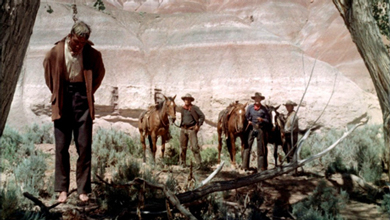
The pictures were filmed in tandem in Utah. Back on Hellman's first film and on some runaway productions made in Puerto Rico, unbilled executive producer Roger Corman had determined that splitting costs between two or even three films was a good practice. Hellman and Nicholson put together a pair of screenplays that could be filmed on Corman's budget of $150,000 dollars. Not sure whether his fortune lay in acting or writing, Nicholson wrote Ride in the Whirlwind, a small-scale Ox-Bow Incident uninterested in making a socially conscious statement. Cowboys Vern, Wes and Otis (Cameron Mitchell, Jack Nicholson & Tom Filer) stop off to rest at a line shack occupied by several nervous, well-armed men. Leader Blind Dick (Harry Dean Stanton) tells them to pay no attention to a colleague who 'fell on his knife.' The three figure that their hosts are outlaws, but don't rush away so as not to provoke violence. It doesn't do any good. In the morning, a posse arrives and lays siege to the cabin. With no chance to protest or negotiate, Vern and Wes barely climb a box canyon to make their getaway. They arrive at a lonely squatter's ranch, scared and hungry, needing to steal horses to survives. Mother Catherine and daughter Abigail (Katherine Squire and Millie Perkins) offer no resistance but Pa Evan (George Mitchell) decides to fight.
Ride in the Whirlwind's finer qualities begin with Monte Hellman's refusal to go for big dramatic effects and climaxes. We're given no standard cues for 'genre outcomes' -- nobody is an obvious hero, characters don't live and die based on their billing in the credits. Our unlucky heroes do their best in a situation with no good options, and neither loses their head or makes speeches to the other (or the audience) about the cruel, senseless chain of events that forces them to hurt others in self defense. Hellman's treatment is refreshingly dry.
It's refreshing to see all of these western situations play out in such a logical fashion. The crooks aren't particularly vicious, the posse is honest in their duty and everybody knows the score. It even makes sense that the old rancher would risk his life and that of his daughter and wife, to hang onto a couple of horses. The mother doesn't even try to stop him -- apparently the loss of the horses is a life & death calamity in itself. Gregory Sandor's cinematography is excellent, especially considering that the tiny filming unit likely had no access to dailies to see how things were coming out. A couple of shots with soft focus do slip through. Cameron Mitchell can be singled out for acting honors, although an unreleased film does little good for its talent. Jack Nicholson is nicely subdued in his secondary role. The dialogue in his is excellent: we're told that he found much of it by reading old books and journals at the Los Angeles Public Library. Besides Harry Dean Stanton, who stands out even when he underplays, we have Rupert Crosse (The Reivers) excellent as a bearded bandit and the married acting couple Katherine Squire (Lolly-Madonna XXX) and George Mitchell (The Andromeda Strain) efficiently sketching the hardscrabble frontier couple. Tom Filer was a would-be writer like Nicholson but his filmography is far shorter -- for Roger Corman's underfed The Beast with a Million Eyes (screenplay) and William Alland's ambitious, pacifist Sci-fi melodrama The Space Children (story).
The small but finely crafted Ride in the Whirlwind hasn't much to sell a public that in 1966 expected lavish action westerns such as Richard Brooks' The Professionals. The wholly existential The Shooting doesn't even try to compete at the commercial level. In genre terms it's like one of Budd Boetticher's modest Randolph Scott westerns, in which three or four nervous characters become uncomfortable fellow travelers on a dangerous road. This time the desert 'quest' is an almost complete mystery. 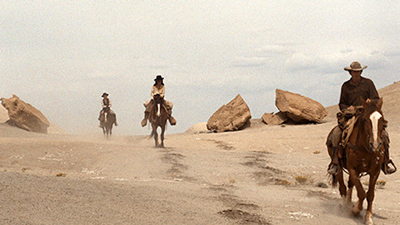
Willettt Gashade (Warren Oates) returns to find his hilltop mining camp a mess. One partner Leland Drum is dead and buried, shot by persons unknown who perhaps mistook him for Willettt's brother Coigne, who has departed as well. The remaining fourth partner Coley Boyard (Will Hutchins) tells Willettt a fuzzy story -- Coigne may have killed a man and a a child, and has fled in fear of reprisals. Willettt has barely arrived when an attractive, determined woman (Millie Perkins) arrives. She refuses to give her name but hires them for an outrageously high sum to guide her to the town of Kingsley. As much as he tries, Gashade can't get more information out of her. On the way she shoots her gun off at frequent intervals and keeps the inexperienced Coley off balance by pretending an interest in him. They're eventually joined by the dandified Billy Spear (Jack Nicholson), a hired gun with a lightning-fast draw and a threatening personality. Before long the tiny group is on a forced march, in pursuit of an unnamed man riding ahead. The woman still won't identify herself or their quarry; the horses begin to die. Billy Spear makes it obvious that their lives are in danger, so Willettt tries to protect Coley by having him left behind. Where are they going? Who are they after, and why? Filmed under the title Gashade, Hellman's The Shooting isn't completely mysterious; it's just that Carole Eastman, writing under the name Adrien Joyce, lets us know only what Willett Gashade knows. As most of the clues are mentioned once and not reinforced as in a more conventional mystery, casual viewers may not know what the heck is going on. The quartet of characters is fascinating. The mystery woman shot her horse to put it out of her misery, but Willett can't find a broken bone to explain why. The immature Coley is impossibly chirpy and light-hearted considering the dark circumstances, and too optimistic to believe Billy Spear's threat: "I'm going to shoot your face off." The only reason Billy is with them is because he misinterpreted a random gunshot from Coley as a signal from the woman to join the party. 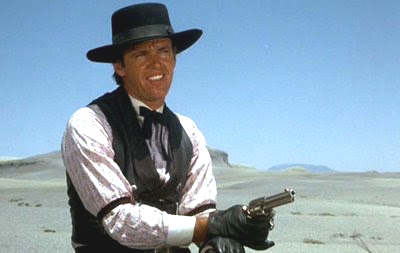
The screenplay doesn't hide information; but only Willett is trying to process it and has nobody to share his doubts with. He knows that his life is in danger but can only guess at the woman's deadly mission. The Shooting is a more realistic 'road' western than most; the plot launches a bit like Henry Hathaway's Garden of Evil. A number of trek scenes in the bleak & bare scenery of Kanab, Utah are quite beautiful, especially one extended shot of the horses at sunset. Critic Philip French compared cameraman Gregory Sandor's images of the desert to art by abstract expressionist Adolph Gottlieb. A cutaway to a blazing sun -- apparently a simple artwork setup on an animation stand - does indeed resemble Gottlieb's paintings. Old TV broadcasts with commercials made The Shooting completely indecipherable, but seen in such good quality the quizzical ending now seems appropriate. Hellman steps suddenly into the same step-printed "weird zone" effect seen at the end of Two-Lane Blacktop. The picture plays out in just three or four strange shots and a fateful one-word line of dialogue. Helllman embraces the mystery; we must compare costumes in shots of Warren Oates to realize what's happening. Warren Oates is masterful, for once playing someone not meant to be a fool or hillbilly -- Philip French relates his name Willett Gashade to a lyric in the old western tune Jesse James" "This song was made by Billy Gashade / As soon as the news did arrive." 1 With her much bigger role in this film, Millie Perkins is impressively secretive -- the opposite of western heroines that start out cold only to melt into meek dependence. Since she doesn't explain her obsession we can't evaluate her any more than Willett can. Will Hutchins' makes Coley a likeable doofus without trying to endear us to him; it's enough that Willet is protective of the young man. Ten years into his screen career, this may be the first film in which Jack Nicholson has his act together -- he was reduced to playing bits in non-Corman pictures. Early Roger Corman fans followed his adventures in Little Shop of Horrors, The Raven and The Terror. Nicholson seems very into the role of Billy Spear, playing him a bit like Jack Palance in Shane, only with more narcissism and '60s cool. Thanks to what looks like a camera speed trick, Spear is also given an impressively fast gun draw. The attitudes and pitch of the characters are very well judged -- Spear, the woman and Gashade have a lot to say to each other but almost all of the communication happens between the lines. The Shooting is as existentially moody as La'avventura, thanks to its deft handling of western conventions. 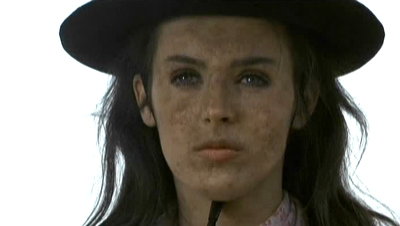
Monte Hellman had a couple additional feature credits before this but worked mostly as an editor and fill-in director whenever Roger Corman was piecing together runaway productions or doctoring a foreign film for domestic release. Corman is unbilled here to keep the movie under the union radar -- he was already a Guild member by this time. Hellman took no editing credit on The Shooting or Ride in the Whirlwind for the same reason. When no distributor stepped up, Corman almost immediately sold the films to Walter Reade, which eventually released them to TV. Neither film was registered for copyright until 1982. With that history, it's a miracle that the film elements have survived; ownership is now listed through an entity called SGF Enterprises. Criterion's Blu-ray of The Shooting and Ride in the Whirlwind is a welcome disc. Until now I've never seen these pictures in reasonable quality. Colors are now excellent and the cinematography accomplished. Exteriors never have too much 'Hollywood' fill lighting. The cabin scenes in Whirlwind are very nicely lit. Composers Richard Markowitz and Robert Drasnin come up with cues that don't telegraph the director's intentions; the music in The Shooting doesn't say, 'spacey ending coming'. Neither in composition or cutting does Hellman reveal his game plan. In addition to approving the video transfer, Hellman generated most of the extras. He speaks on a commentary with film historians Bill Krohn and Blake Lucas, and hosts on-camera interviews with several actors, including a genial Millie Perkins and a frail Harry Dean Stanton. Future Star Wars producer Gary Kurtz talks about production details. Jake Perlin conducts an interview with actor Will Hutchins, while Kim Morgan praises Warren Oates in a visual essay. The foldout liner insert features an essay by Michael Atkinson. Learning more about the 'mysterious' The Shooting and Ride in the Whirlwind only makes them more enjoyable. They stand head and shoulders above 'alternative' westerns like Zachariah, The Hired Hand and even Greaser's Palace.
On a scale of Excellent, Good, Fair, and Poor, 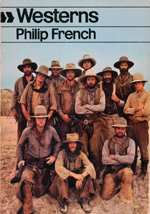
1. Westerns by Philip French. Cinema One Series by Viking Press, New York 1973.
French's overall thematic analysis of the genre hasn't been bettered, and since 1973 few new westerns have broken new ground, his book still feels current and vital. He does have his personal preferences. Spaghetti westerns make no appearance. Right up front French says that a study of them is warranted, but doesn't volunteer for the job. He mentions a filmography of 155 Italian westerns, "which to me reads like a brochure for a season in hell."

The version of this review on the Savant main site has additional images, footnotes and credits information, and may be updated and annotated with reader input and graphics.
Review Staff | About DVD Talk | Newsletter Subscribe | Join DVD Talk Forum |
| ||||||||||||||||||